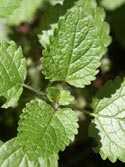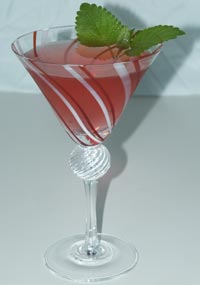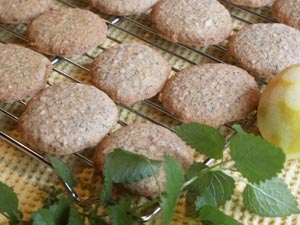Lemon Balm, Herb of the Year 2007
by Susan Belsinger
A harbinger of spring and a true summer essence, the fragrance of the leaves of lemon balm is a pleasant mingling of lemon and sweet honey. Balm’s perfume, however, is not the only significant attribute in its two thousand year old history. The botanical name, Melissa officinalis, derived from the Greek word for bee, is indicative of its extreme attractiveness to bees. The balm patch is abuzz with activity in the summer when the tiny white flowers appear on this easy-to-grow perennial plant. Parkinson described Melissa, “Of a sweet smell, coming neerest to a Citron or Lemmon” and as a remedy against the stinging of bees.
Native to Southern Europe, Asia, and North Africa, lemon balm has always been associated with longevity. An infusion of balm with honey was a popular drink in ages when long life offered the possibility of wisdom and the calm reflective joys. It has also been used for centuries to reduce fevers. Balm wine or tea was also recommended to scholars for sharp memories and a clear head and, somewhat conflictingly, to insomniacs for its alleged sleep-inducing properties.
Paracelsus, a Swiss physician of the early 1500s made an elixir he claimed to revitalize the strength of man and almost make him immortal. Evelyn stated, “Balm is sovereign for the brain, strengthening the memory and powerfully chasing away melancholy”. When the leaves of balm are combined with nutmeg, lemon peel, cinnamon, and cloves and infused in alcohol, the result is the famous Eau de Carmes (also known as Eau de Melisse), an aromatic cordial made by the Carmelite nuns back in the 17th century. Supposedly it is a good muscle relaxant when used for a massage; Emperor Charles V was known to use it in his bath and smell of it “to refresh and preserve his intellect”.
Lemon balm has antioxidant, antispasmodic, and antiviral properties, as well as being calmative, carminative, diaphoretic, febrifuge, and a stomach tonic. Therefore an infusion of the leaves can be used for mild depression, headache, as a digestive aid for gas, bloating, and an upset stomach, to reduce fevers, and to help calm nerves, relieve anxiety and stress, and promote sleep. It seems to have an overall tonic effect for the body. Fresh lemon balm is of course, the best-tasting and most effective medicine. Dried lemon balm will also work, but much of the delightful fragrance of the fresh herb is lost when dried. I like preparing tinctures, distillates, vinegars, and syrups with fresh balm to use during the winter months when sweet Melissa is sleeping in the garden.
Recently, studies have shown that an ointment made with lemon balm is effective in treating herpes simplex. Although these European creams are not yet available in the U.S., a lemon balm infusion can be taken internally and applied externally to cold sores with clean cotton balls. Lemon balm tinctures are also available.
There have not been any reported side effects or toxic symptoms from the use of lemon balm; however, it should not be used by pregnant or nursing women. If taking thyroid medication or sedatives, check with a healthcare practitioner before using lemon balm.
In the kitchen, balm contributes a subtly sweet grassy flavor and a hint of lemon to a variety of foods and drinks. I use sweet Melissa most often as a fresh leaf tea, or combined with green or black tea. I pretty much always put a handful of leaves into each pitcher of iced tea that I prepare during the spring and summer months, finding that it lightens and enlivens each glass. I make lemon balm syrup fairly often and use it with sparkling water as a natural soda. I also use the syrup in other beverages and punches, over fresh fruit, and as a glaze on muffins, cakes, and scones.
Balm goes well with light foods like fruits, green salads, summer vegetables, grains, baked fish or chicken, and is a lovely addition to sorbets, ice creams, puddings, and macerated fruits. Add the leaves very near the end of cooking, as its volatile oils are dissipated by heat. Its fragrance keeps fairly well in baked goods because its essence is captured in the batter or dough. Here are some delicious ways to ingest lemon balm.
Here’s a few of Susan’s favorite Lemon Balm recipes:
Lemon Balm Syrup
Herb syrups are wonderful flavor essences that can be added in place of the liquid in cakes, pie filling, and sorbets. They are good on all kinds of fruits and used in beverages. Make these when you have fresh herbs in abundance, their flavor and aroma will bring a brightness to fruits and desserts. This makes a delightful natural soda when mixed with about an equal amount, or a bit more, sparkling water.
Makes about 2 cups
1 1/2 cups water
1 1/2 cups sugar
About 8 to 10 sprigs lemon balm, or a large handful of leaves
To make the syrup, combine the water and sugar in a small saucepan, add the herbs bruising the leaves against the side of the pan with a spoon. Place over moderate heat and bring to a boil. Cover, remove from heat and let stand for at least 30 minutes.
Remove the leaves and squeeze them into the syrup to extract their flavor. Pour into a clean bottle or jar and label. This syrup can be made ahead and kept in the refrigerator for about 4 weeks.
If you want to keep the syrups for a long period of time, pour them into jars or bottles leaving at least an inch of headspace, place on the lid or cap, and label. I freeze them for up to one year. Remove from freezer the night before using and allow to thaw, or place the bottle in a bowl of warm (not hot) water to thaw more quickly, use what you need, and refreeze right away.
Lemonbalmolitan
Lemon balm elevates the cosmopolitan to new heights. These are so smooth to drink-they go down easy. You could use lemon verbena or lemon basil here, but the name won’t sound as good. Make a non-alcoholic version substituting lemonade for the vodka and triple sec.
Makes 1 drink
10 to 12 lemon balm leaves
1 1/2-ounces lemon-flavored vodka
3 ounces cranberry juice
3/4 ounce triple sec
Wedge of lime
Crushed ice
Muddle the balm leaves in the bottom of a cocktail shaker. Add the vodka, triple sec. cranberry juice, and squeeze in the juice of the lime wedge. Add a generous cup of crushed ice and shake for 10 seconds. Strain the liquid into a chilled martini/cosmopolitan glass and garnish with a lemon balm leaf.
Miso Soup with Garlic, Ginger, and Lemon Balm
This simple, flavorful soup is so easy and is the perfect quick-fix for when you need a pick-me-up, something warming and nourishing, and it is great for a cold or flu.
Serves 2; or a bowl for now and 1 for later
3 cups water
About 1-inch piece fresh gingerroot
3 large cloves garlic, sliced thin lengthwise
1 tablespoon mellow white, or yellow miso
5 or 6 sprigs lemon balm, about 4-inches long
Lemon balm leaves for garnish
Heat the water over medium heat in a small non-reactive saucepan. Peel the gingerroot and slice it into coins (crosswise in thin slices). Add the gingerroot and garlic to the saucepan. When the water comes to a boil, reduce the heat and cook the ginger and garlic at a bare simmer, covered, for about 15 to 20 minutes. Remove from heat.
Put the miso in a small bowl and add about 1/4 cup of the hot decoction to the miso and stir with a fork until the miso is dissolved. Add the dissolved miso to the saucepan along with the lemon balm and use the back of a spoon to bruise the balm leaves against the side of the pan. Cover and let sit for about 5 minutes.
Remove the balm sprigs, pressing them against the side of the pan to release their essence. Use a slotted spoon to remove the ginger slices. I leave the garlic slices in the broth (they are the prize at the bottom of the bowl at the end). Serve the soup in a favorite bowl, garnished with a few fresh lemon balm leaves, or some cut into chiffonade.
Lemon Balm Poppy Seed Butter Cookies
Delightful with tea, lemonade, or a glass of wine, these cookies are simple to make and any herb can be used. This cookie recipe is versatile and is very good with just about any herb, though the lemon herbs are quite lovely, especially with the traditional addition of poppy seeds. They keep well in a tin, or up to 2 months in the freezer.
Makes about 3 to 4 dozen cookies
12 tablespoons unsalted butter, softened
2/3 cup sugar
1 large egg
1/2 teaspoon vanilla extract
2 cups unbleached white flour, sifted
3 tablespoons minced fresh lemon balm leaves, or other lemon herbs
1 1/2 to 2 teaspoons lemon zest
1 tablespoon poppy seeds
Pinch of salt
Cream the butter and sugar. Beat in the egg and the extract. Gradually mix in the flour, and stir in the minced herb, lemon zest, poppy seeds, and a pinch of salt. The dough will be soft. Divide the dough into 2 parts. Using plastic wrap to shape the dough, roll each part into a cylinder about 1 1/4-inches in diameter. Chill the rolls for an hour, or place in the freezer for 20 minutes.
Preheat the oven to 350 ° F. Remove the plastic wrap and slice the dough into 1/4-inch rounds. Place the cookies on ungreased baking sheets and bake for about 10 minutes, until the cookies are a light golden brown. Remove the cookies from the baking sheets while they are hot and cool on racks.
This recipe is excerpted from Susan’s new book not just desserts-sweet herbal recipes.
Goodnight Milk
Since lemon balm has soothing and relaxing properties, a tea of it is a good thing before bed. Drinking warm milk before bed is also a recommended practice for a good night’s sleep. Here, I’ve combined the two traditions to make a simply delicious beverage to consume before retiring. You can use honey in place of the maple syrup, but the flavor of maple is “just right” here-it is yummy. Sleep tight!
1 serving
6 to 8 sprigs fresh lemon balm 2 to 3-inches long
1 cup milk
About 1 teaspoon maple syrup
Rinse the balm leaves, shake off the excess water, and scrunch it up to bruise the leaves. Put the balm in a small non-reactive saucepan and pour the milk over it. Place over medium heat, and stir, bruising the balm against the side of the pan with the back of a spoon. Add the maple syrup and stir to dissolve. Bring the milk just barely to a simmer, turn off heat, and cover the pan with a lid or saucer. Let sit for 5 minutes.
Strain the leaves from the milk into a mug and press on them to remove their essence. Inhale. Drink slowly.
Variations:
~ You can make this with dried lemon balm, and receive the same health benefits, though much of the delightful fragrance of the fresh herb is lost when it is dried.
~ Use about 1 teaspoon of lemon balm distillate in place of the lemon balm leaves; stir it in with the maple syrup. Taste, and adjust with a little more if necessary.
~ Use 2 to 3 teaspoons of lemon balm syrup-stir it in when the milk is hot-you will not need the maple syrup.
Sources
Dille, Carolyn, and Belsinger, Susan. Herbs in the Kitchen. Interweave Press: Loveland, CO, 1991.
Duke, James A., Ph.D. The Green Pharmacy. Rodale Press: Emmaus, PA 1997.
Foley, Daniel J. Herbs for Use and Delight. Dover Publications: NY, 1974.
Gladstar, Rosemary. Rosemary Gladstar’s Family Herbal, Storey Books: North Adams, MA, 2001.
Tierra, Michael, L.Ac., O.M.D. The Way of Herbs. Pocket Books: NY 1998.
Tucker, Arthur O., and DeBaggio, Thomas. The Big Book of Herbs. Interweave Press: Loveland, CO, 2000.
http://www.botanical.com/botanical/mgmh/b/balm–02.html http://www.swsbm.com/Constituents/Melissa_officinalis.txt http://www.umm.edu/altmed/ConsHerbs/Print/LemonBalmch.html






